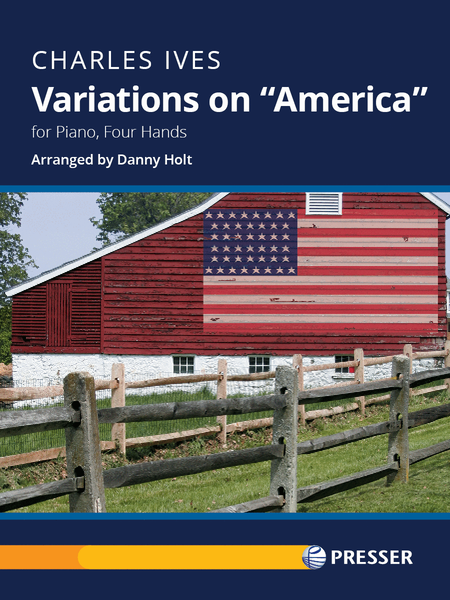Variations on "America"
-
Ships in 1 to 2 weeks
Details
Description
SKU: PR.110418370
Composed by Charles Ives. Arranged by Danny Holt. Performance Score. 20 pages. Duration 8 minutes. Theodore Presser Company #110-41837. Published by Theodore Presser Company (PR.110418370).ISBN 9781491135075. UPC: 680160686247.
Composed as an organ solo by the 17-year-old Ives for his own performance purposes, the beloved Variations on "America" is a treat for any occasion, whether a holiday concert, a serious recital, or other special event. Danny Holt’s transcription for Piano, Four Hands adds a dazzling new option to play at home or on stage, taking best advantage of Ives’ tremendous contrasts in color, dynamics, and texture.
Composed when Charles Ives was a teenager, Variations on “America” is both a convenient introduction to Ives’ body of work, and an early example of his iconoclastic musical voice and creative genius. Just a few years after composing this piece, Ives would leave home to study music at Yale. But until then he had been taught by his father, George (who had been a bandmaster in the Civil War). George subjected the young Ives to experiments such as singing a song in one key while being accompanied in another, or arranging for two marching bands to converge on a town center, with the resulting cacophony that ensued.The Variations exemplifies an early period of experimentation in Ives’ work, spurred on by the unusual pedagogy of his father. The piece is particularly notable for its use of bitonality in the two interludes, subtly foreshadowing more well-known examples by Stravinsky, Bartók, and others by approximately two decades.The bitonal interludes were so ahead of their time, in fact, they were omitted from the first copy that was submitted to a publisher in 1892. (Alas, the piece was rejected even despite these “shocking” elements having been left out, and it wasn’t published until more than five decades later.) There is some ambiguity about when exactly Ives added the interludes into his manuscript copy, though ample evidence suggests he had performed the piece with the interludes around the time he notated the piece in 1891-92. In any case, in light of this piece and his other polytonal explorations from the last decade of the 19th century, it seems fair to give Ives credit for being a pioneer in this area!This arrangement for Piano, Four Hands, closely follows Ives’ original version for organ, setting aside William Schuman’s popular adaptation for symphony orchestra and William Rhoads’ band transcription of the Schuman orchestration. Pianists will find that the piece translates well to the instrument. Ideally, the choreography and logistics of elbow-to-elbow four-hands playing approximates the wild joy one gets from watching an organist play the piece (e.g., the elaborate pedal part in the final variation).In preparing this publication, attention was paid to details in the dual Critical Editions (Presser 443-41003) of both Ives’ manuscript edition and the 1949 publication edited by organist E. Power Biggs (who is credited with discovering what had been a long-lost, forgotten work.) But as with much of Ives’ output, attempting to create a true ‘urtext’ score is a futile endeavor, and especially with a piece such as this one – in which Ives incorporated improvisation in live performance – seems unnecessary anyhow. True die-hards are of course encouraged to consult the critical editions and even find inspiration in the orchestrated version. Generally, performers are advised to be wild, have fun, and not to be too rigid in their interpretive choices.Dynamics in this arrangement mostly follow the organ score closely. Pianists will use good judgment about pedaling throughout, which should be straightforward and intuitive. Courtesy accidentals have been provided frequently – without parentheses – balancing the need for extra clarity in the context of Ives’ murky musical language, and a desire to avoid unnecessary clutter.A few notes that might inform interpretive decisions:mm. 15-16: There are inconsistencies here between Ives’ original manuscript and the 1949 Biggs edition, regarding the top voice in m. 15, beat 3 (C# vs. Cn) and m. 16 (D Major vs. D Minor).mm. 76-84 & 143-146: In both Interludes, Ives emphatically notates extreme dynamic contrast, in order to highlight the bitonality. Although it may seem counterintuitive (or even a misprint, as has apparently been misconstrued by some), performers are urged to follow the composer’s marking!m. 109: Two-note slurs have been added here for clarity and consistency with other similar passages, though they do not appear in either the original manuscript or Biggs.m. 112: The last two eighth notes of Primo appear as 16ths in the original manuscript.mm. 183-186: The original manuscript has a slightly different bass line.mm. 184 & 186: Primo gestures have been re-written to be slightly more idiomatic for Piano, Four Hands.m. 186: The breath mark at the end of this bar does not appear in either the manuscript or Biggs, but is an editorial suggestion – aside from being appropriately dramatic, it will indeed be necessary in a reverberant hall!I would like to thank Steven Vanhauwaert, the other half of my piano duo, 4handsLA, for his input on early drafts of this arrangement.— Danny Holt, April 2022.

 Share
Share